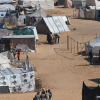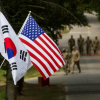
On Sept. 11 of last year, the U.S. military passed a little-noticed milestone. For the 21 years before that date, virtually all U.S. service members were issued the Global War on Terrorism Service Medal. From now on, it’s being given only to troops who work directly on a counterterrorism operation for more than 30 days.
That may seem a minor distinction, but what it means is that it’s no longer assumed that any U.S. service member is working in support of a counterterrorism mission — an acknowledgment that with the withdrawal of U.S. troops from Afghanistan, an era in U.S. defense policy has come to an end. The Global War on Terrorism (GWOT, as it was once officially known) is not a thing of the past, but it’s fair to say it’s not the all-consuming priority it was in the two decades that followed the 9/11 attacks.
But of course that doesn’t mean the world is now at peace — or that the U.S. military has pulled back from the global stage. As 2023 begins, there are hundreds of thousands of U.S. forces deployed around the world.
Six months after the last American troops left Afghanistan, the Russian military invaded Ukraine. While U.S. troops weren’t sent into combat as a result, the invasion did prompt an unprecedented military assistance effort that has included the deployment of tens of thousands of additional troops to Europe to shore up NATO’s eastern flank. Meanwhile, U.S. tensions with China, which the Biden administration describes in its national security strategy as “the only competitor with … the intent to reshape the international order,” are also prompting a redistribution of U.S. resources, including troop deployments.
And beyond these high-profile security concerns, there are U.S. troops deployed from Niger to Djibouti to the Philippines, and dozens of other missions that have merited little or no debate in Congress or coverage in the media.
What are those troops doing in all these different parts of the world? The answers help paint a picture of the U.S. global military posture, nearly a quarter-century after the 9/11 attacks.

Remnants of the war on terrorism
After the withdrawal of the last troops from Afghanistan, President Joe Biden assured the country that the global fight against terrorist groups would continue.
“We have what’s called over-the-horizon capabilities, which means we can strike terrorists and targets without American boots on the ground — or very few, if needed,” he said.
Almost a year and a half later, we’re starting to get a better idea of what this “over the horizon” counterterrorism war looks like. In some places, it does indeed involve “boots on the ground,” though in far fewer numbers than were seen in the peak years of the Global War on Terrorism.
The U.S. still has some 900 troops in Syria, where they continue to conduct operations targeting the Islamic State (ISIS) in cooperation with Kurdish forces who control much of the northeast of the country. This has been a huge irritant to NATO ally Turkey, which considers those Kurdish forces a terrorist group and has launched repeated military incursions targeting their positions in Syria.
Though the U.S. combat mission in Iraq formally ended in 2021, some 2,500 U.S. troops remain in the country, and U.S. commanders don’t expect that to change for the foreseeable future. Though the troops are there on what the military calls an “advise and assist” mission to help the Iraqi forces fighting ISIS and haven’t led combat operations in years, these American troops and those based in Syria have been frequently targeted by Iran-backed militia groups.
Shortly after taking office, Biden announced an end to U.S. support for the controversial Saudi-led war against the Iran-backed Houthis in Yemen. But the White House said a “small number” of troops are still deployed in Yemen to conduct operations targeting ISIS and the group al-Qaeda in the Arabian Peninsula. According to data from New America, it’s been over a year since these forces carried out a publicly reported drone strike or ground operation.
According to a letter last month from the president to Congress detailing troop deployments around the world, as required by the Vietnam-era War Powers Resolution, 2,755 troops are also deployed to Saudi Arabia to “protect United States forces and interests in the region against hostile action by Iran and Iran-backed groups.” U.S. troops are also providing “military advice and limited information” to the Saudi-led coalition fighting in Yemen, which the White House stresses is a “noncombat” role.
Since the 2021 pullout and Taliban takeover, no U.S. troops have been based in Afghanistan, but according to the White House, American forces “remain postured outside Afghanistan to address threats to the U.S. homeland and U.S. interests that may arise.” These operations included the drone strike last August that killed al-Qaeda leader Ayman al-Zawahiri.
One other often forgotten remnant of the post-9/11 era: Around 1,800 U.S. troops continue to operate the detention facility at Guantánamo Bay, Cuba — now for just 35 remaining detainees.
“I think the picture is largely one of continuity in many respects,” Brian Finucane, a former State Department legal adviser on military issues, now with Crisis Group, told Grid. “You see a lower operation tempo, what you might call GWOT-lite, but continuity in terms of deployments or even some increases in places in Africa.”
Africa: the war’s new frontier
In addition to the missions listed above, U.S. troops are working in a “train and assist” capacity for counterterrorism operations in countries including the Philippines, Lebanon and Jordan. But increasingly, the focus has shifted to Africa.
In May 2022, Biden signed an order to redeploy roughly 500 U.S. troops to Somalia, reversing Donald Trump’s 2020 decision to remove troops from the country. Somalia has been the most active counterterrorism battlefield of the Biden era, according to New America’s tracking data, with 16 drone strikes targeting the militant group al-Shabaab in 2022. U.S. troops are also deployed to neighboring Kenya and Djibouti to support the operations in Somalia.
Meanwhile, according to the White House War Powers notification, U.S. military personnel are deployed to several countries in the Lake Chad Basin and Sahel region, in Western Africa, to “conduct airborne intelligence, surveillance, and reconnaissance operations” to assist counterterrorism operations by local and European militaries. These include 1,001 U.S. troops in Niger, an increase from around 773 when the last report was issued in June. The U.S. operates a drone base in Niger and has increased its cooperation in recent years with the government of what is, by some measures, the world’s poorest country. The U.S. deployment to the country made headlines in 2017, when a joint patrol was ambushed by a local ISIS affiliate, killing four U.S. and four Nigerien troops.
The incident sparked a brief debate over a deployment that most Americans knew nothing about. Even Sen. Lindsey Graham (R-S.C.), a prominent national security hawk who sits on the Armed Services Committee, admitted that he “didn’t know there was a thousand troops in Niger.” Five years later, those troops remain. While the U.S. government has provided few details about current U.S. deployments in other countries in this region, there have been recent American military operations in Cameroon, Chad, Mali and northern Nigeria as well.
All these deployments raise separate questions about the nature of the various missions. For one thing, it’s not clear that local terrorist groups in these countries pose any risk to the U.S. — and therefore whether these missions are in the U.S. national interest. The argument for these missions is that these groups are tied to global networks like ISIS and al-Qaeda and could metastasize into global threats. For now, the U.S. troops have not generally been in direct combat with these groups, except for those instances when the Americans themselves come under attack.
But it’s also the case that in countries such as Somalia, ostensibly “noncombat missions” have morphed into something more ambitious. As one U.S. official put it, discussing the drone base in Niger, so far used just for reconnaissance purposes, “once you have the facility, you want to use it or the host government wants you to use the capabilities on their behalf.”
These aren’t the only concerns. In Burkina Faso and Mali, U.S.-trained officers have been involved in military coups in recent years. In Nigeria, they’ve been accused of serious human rights abuses.
Europe: the new threat
The U.S. has had a large, though steadily declining, troop presence in Europe for decades. Biden took some steps to slow that decline shortly after taking office, halting a Trump order to reduce troop levels in Germany. Then came the Russian invasion of Ukraine.
The U.S. has sent some 20,000 additional troops to Europe since then as part of an effort to bolster NATO’s defenses, assist Ukraine’s war efforts and deter Russia from further aggression. This includes additional deployments to Poland, the Baltic countries and to Romania, where the Army’s 101st Airborne Division is conducting exercises just miles from the Ukrainian border in its first European deployment since World War II.
Despite these increases, the total number of U.S. troops in Europe, around 100,000, is back to only about where it was before cuts made during the Obama administration, and far from Cold War levels, which peaked at 430,000 troops in the late 1950s.
Coming soon: a military pivot to Asia?
The U.S. may have made China the centerpiece of its national security policy and increased the tempos of drills with allies in the region, but the numbers of troops at longtime U.S. bases in Japan and South Korea have stayed fairly static at around 61,000 and 28,000 respectively.
That may change. The Pentagon has recently announced plans to bolster the U.S. military presence in Australia, including air, sea and land forces, all with an eye on China.
The big picture
“The U.S. military’s role is multifaceted, globally. And it’s not always apparent why the U.S. has this number of troops in various place,” Michael Allen, a professor at Boise State University whose work tracks U.S. overseas deployments, told Grid. While the U.S. discloses the number of troops on what it calls “permanent deployments” overseas, reporting on those deployed into combat can be patchy. For much of the Trump administration, to take an extreme example, the U.S. did not even disclose the number of troops deployed to Iraq, Afghanistan and Syria.
Overall, the number of U.S. troops deployed overseas has declined steadily since the Cold War, with an uptick during the post-9/11 years. And no country today has anywhere near the level of American forces seen at the height of the wars in Iraq and Afghanistan — when there were more than 168,000 and 110,000 troops deployed to those countries, respectively.
But it remains a fact that while the “Global War on Terrorism” may no longer be the defining feature of American military deployments, U.S. forces are currently stationed in (and in a few cases, actually fighting in) a remarkable number of countries with little public debate or awareness back home about what exactly they are doing.
Source: GRID

















